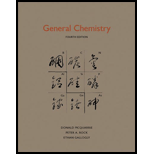
(a)
Interpretation:
The reaction order on each reactant and the overall reaction order have to be predicted along with the classification of reaction.
Concept Introduction:
Rate law or rate equation: The relationship between the reactant concentrations and reaction rate is expressed by an equation.
Order of a reaction: The order of a reaction with respect to a particular reactant is the exponent of its concentration term in the rate law expression, and the overall reaction order is the sum of the exponents on all concentration terms.
Elementary step: The first step in a reaction mechanism is said to be elementary step.
Unimolecular: A molecule undergoes rearrangement itself to give one or more products is said to be unimolecular reactions.
Bimolecular: Two molecules undergo collision to give one or more products is said to be bimolecular reactions.
Trimolecular: Three molecules undergo collision to give one or more products is said to be trimolecular reactions.
(a)
Explanation of Solution
Given,
Reaction order on each reactant:
The order of
The order of
The overall order of the given reaction is,
In the given elementary steps, there are two molecules undergo collision to form a product. So, from the definitions above said the given elementary step is bimolecular.
(b)
Interpretation:
The reaction order on each reactant and the overall reaction order have to be predicted along with the classification of reaction.
Concept Introduction:
Refer to (a).
(b)
Explanation of Solution
Given,
Reaction order on each reactant:
The order of
The overall order of the given reaction is,
In the given elementary steps, there are two molecules undergo collision to form two products. So, from the definitions above said the given elementary step is bimolecular.
(c)
Interpretation:
The reaction order on each reactant and the overall reaction order have to be predicted along with the classification of reaction.
Concept Introduction:
Refer to (a).
(c)
Explanation of Solution
Given,
Reaction order on each reactant:
The order of
The order of
The overall order of the given reaction is,
In the given elementary steps, there are two molecules undergo collision to form products. So, from the definitions above said the given elementary step is bimolecular.
Want to see more full solutions like this?
Chapter 18 Solutions
General Chemistry
 ChemistryChemistryISBN:9781305957404Author:Steven S. Zumdahl, Susan A. Zumdahl, Donald J. DeCostePublisher:Cengage Learning
ChemistryChemistryISBN:9781305957404Author:Steven S. Zumdahl, Susan A. Zumdahl, Donald J. DeCostePublisher:Cengage Learning ChemistryChemistryISBN:9781259911156Author:Raymond Chang Dr., Jason Overby ProfessorPublisher:McGraw-Hill Education
ChemistryChemistryISBN:9781259911156Author:Raymond Chang Dr., Jason Overby ProfessorPublisher:McGraw-Hill Education Principles of Instrumental AnalysisChemistryISBN:9781305577213Author:Douglas A. Skoog, F. James Holler, Stanley R. CrouchPublisher:Cengage Learning
Principles of Instrumental AnalysisChemistryISBN:9781305577213Author:Douglas A. Skoog, F. James Holler, Stanley R. CrouchPublisher:Cengage Learning Organic ChemistryChemistryISBN:9780078021558Author:Janice Gorzynski Smith Dr.Publisher:McGraw-Hill Education
Organic ChemistryChemistryISBN:9780078021558Author:Janice Gorzynski Smith Dr.Publisher:McGraw-Hill Education Chemistry: Principles and ReactionsChemistryISBN:9781305079373Author:William L. Masterton, Cecile N. HurleyPublisher:Cengage Learning
Chemistry: Principles and ReactionsChemistryISBN:9781305079373Author:William L. Masterton, Cecile N. HurleyPublisher:Cengage Learning Elementary Principles of Chemical Processes, Bind...ChemistryISBN:9781118431221Author:Richard M. Felder, Ronald W. Rousseau, Lisa G. BullardPublisher:WILEY
Elementary Principles of Chemical Processes, Bind...ChemistryISBN:9781118431221Author:Richard M. Felder, Ronald W. Rousseau, Lisa G. BullardPublisher:WILEY





